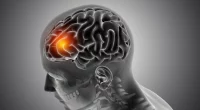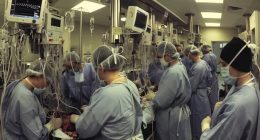Breast pain, also called mastodynia, mastalgia, or mammalgia, can feel like a mild ache, tightness, heaviness, burning, or overall tenderness in one or both breasts. This discomfort often arises due to hormonal changes, but it can also result from infections, injuries, and other causes.
When breast pain is related to the menstrual cycle, it is called cyclical mastalgia, or cyclical breast pain. This type of pain usually happens at the same time each month, typically before a period.
The Breast Cancer Foundation explains that breast pain involves discomfort, sensitivity, or pain in the breast or underarm area. There are many possible reasons for breast pain, but it is important to note that most of the time, breast pain is not an indication of breast cancer.
Breast pain commonly affects the upper, external area of the breasts and may sometimes extend to the arms.
Symptoms
Breast pain is generally classified into two types: cyclical and non-cyclical.
Cyclical breast pain is linked to the menstrual cycle. It tends to come and go in a pattern that matches the cycle. Women often feel tenderness in their breasts, describing the pain as a heavy, mild ache. For some, it feels like discomfort with heaviness, while others might experience a burning or stabbing sensation. The breasts may feel lumpy and swell, but not with a single, lump. Typically, breasts are affected, particularly the outer, and upper parts, and the pain can extend to the armpit. This pain usually intensifies a few days prior to a period starting, though it can start as early as two weeks before the menstrual cycle. Cyclical breast pain is more common in younger females, but postmenopausal females on hormone replacement therapy may also experience it.
Non-cyclical breast pain affects only a single breast, often in a small area, though it can extend over the chest. This type of pain is more frequent among postmenopausal females and does not follow the menstrual cycle. The pain may be sporadic or continuous.
There are specific causes of non-cyclical breast pain. One is mastitis, an infection within the breast that can cause fever, malaise, breast tenderness, swelling, warmth, and redness. The pain is typically described as a burning feeling and is more intense during breastfeeding for lactating mothers. Another cause is extramammary pain, where the pain feels like it is coming from the breast but originates elsewhere. This type, sometimes referred to as “referred pain,” can occur in conditions like costochondritis, which is the inflammation where the cartilage and rib meet.
Causes
Determining the exact cause of breast pain can be challenging, as it may be associated with a variety of factors.
Some common causes include acid reflux, angina, alcoholism alongside liver damage, and psychological issues like stress, anxiety, and depression. Non-cancerous breast tumors and breast cancer are also potential causes, as well as breast cysts and breast traumas from previous surgery or injury.
Breastfeeding can lead to infections that cause pain, while conditions like thoracic radiculopathy and chest wall pain are also contributors. Coronary artery disease and costochondritis (inflammation of the rib cartilage) are additional factors.
Cyclical breast pain related to the menstrual cycle and dietary influences, especially caffeine, can trigger breast pain. Fibromyalgia and herpes zoster (shingles) are other possible causes. Mastitis, an infection in the breast, can cause significant discomfort.
Certain medications such as chlorpromazine, digitalis, oxymetholone, some diuretics, methyldopa, and spironolactone can lead to breast pain. Gastrointestinal issues like peptic ulcers and respiratory conditions such as pericarditis and pleurisy are also linked to breast pain.
Life stages and conditions such as puberty, pregnancy, and psychological factors can contribute to breast pain. Other potential causes include pulmonary embolism, shoulder pain, rib fractures, sickle cell anemia, and chest wall trauma
Treatment Options
For most cases of cyclical breast pain, taking over-the-counter painkillers and putting on well-fitted bras can provide relief. This type of breast pain can be unpredictable, often going away on its own and then returning periodically. Knowing that the pain is cyclical and not due to a more severe condition can encourage many patients, making it easier for them to manage their condition.
Females experiencing non-cyclical breast pain may require specific treatments to address the underlying cause. For example, if the pain is due to infectious mastitis, a course of antibiotics will be prescribed to treat the infection.
Complications of Breast Pain
Due to the numerous potential causes of breast pain, issues can vary depending on the specific reason behind the pain. However, in many instances, there are no significant complications associated with breast pain.
When to consult a healthcare provider
It is important to see your healthcare provider if you notice any of the following changes or symptoms:
- A change in shape or size in one or two breasts.
- Nipple discharge
- A rash over the nipple.
- Dimpling on the breast’s skin.
- Swelling or lump in one of your armpits.
- Pain in your breasts or armpits that is not linked to your period.
- A change in the appearance of your nipple.
- An area of thickened tissue or a lump (mass) in your breast.
These symptoms could indicate an underlying issue that requires medical attention.
Diagnosis of Breast pain
When diagnosing breast pain, a healthcare provider will first try to diagnose if the pain is cyclical, especially if the patient is pre-menopausal. The healthcare provider will likely ask several questions to gather relevant information, including:
- How much caffeine the patient consumes.
- The specific location of the pain within the breasts.
- If there is a pain in the breasts.
- If the patient is a smoker.
- If the patient is taking any medication or using the contraceptive pill.
- If there is a possibility of pregnancy.
- If there are other signs, like lump or nipple discharge.
The healthcare provider will also listen to the patient’s heart and lungs and examine the abdomen and chest to eliminate other potential conditions.
A clinical breast exam is often conducted to check for lumps, modifications in nipple appearance, or discharge. The healthcare provider will also examine the lymph nodes in the lower neck and armpit for any tenderness or swelling.
If a lump, uncommon thickening of tissue, or a particularly painful part is detected, the healthcare provider may order additional tests, such as:
- Mammogram: An X-ray examination of the breast.
- Breast Biopsy: If something doubtful is found, a tiny piece of breast tissue will be surgically removed and analyzed in a laboratory.
- Ultrasound Scan: Uses sound waves to produce pictures of the breasts. This test is often done even if the mammogram does not identify anything.
The individual may also be asked to fill out a breast pain chart to help verify the diagnosis and guide the healthcare provider in determining the best treatment plan.
Summary
Breast pain, either cyclical or non-cyclical, can stem from various causes like hormonal changes, infections, or even psychological factors. Over-the-counter painkillers and well-fitted bras often alleviate cyclical pain, while non-cyclical pain may require specific treatments. It’s important to consult a doctor if there are changes in breast size, shape, or other symptoms like nipple discharge or lumps.
Diagnosis involves questions about lifestyle and health, clinical exams, and potentially further tests like mammograms or biopsies. Complications depend on the underlying cause, but many cases have no significant issues. Regular monitoring and appropriate treatment can effectively manage breast pain.









